Related Research Articles

Hindi cinema, popularly known as Bollywood and formerly as Bombay cinema, refers to the film industry based in Mumbai, engaged in production of motion pictures in Hindi language. The popular term Bollywood is a portmanteau of "Bombay" and "Hollywood". The industry is a part of the larger Indian cinema, which also includes South Indian cinema and other smaller film industries.

Marathi is an Indo-Aryan language predominantly spoken by Marathi people in the Indian state of Maharashtra. It is the official language of Maharashtra, and an additional official language in the state of Goa. It is one of the 22 scheduled languages of India, with 83 million speakers as of 2011. Marathi ranks 13th in the list of languages with most native speakers in the world. Marathi has the third largest number of native speakers in India, after Hindi and Bengali. The language has some of the oldest literature of all modern Indian languages. The major dialects of Marathi are Standard Marathi and the Varhadi dialect.

Urdu is an Indo-Aryan language spoken chiefly in South Asia. It is the national language and lingua franca of Pakistan, where it is also an official language alongside English. In India, Urdu is an Eighth Schedule language whose status and cultural heritage is recognised by the Constitution of India; and it also has an official status in several Indian states. In Nepal, Urdu is a registered regional dialect and in South Africa it is a protected language in the constitution. It is also spoken as a minority language in Afghanistan and Bangladesh, with no official status.

Hindustani is an Indo-Aryan language spoken in Deccan, Northern India and Pakistan, and used as a lingua franca in both countries. Hindustani is a pluricentric language with two standard registers, known as Hindi and Urdu. Thus, it is also called Hindi–Urdu. Colloquial registers of the language fall on a spectrum between these standards. In modern times, a third variety of Hindustani with significant English influences has also appeared which is sometimes called Hinglish.
Indian English (IE) is a group of English dialects spoken in the Republic of India and among the Indian diaspora. English is used by the Indian government for communication, along with Modern Standard Hindi, as enshrined in the Constitution of India. English is also an official language in seven states and seven union territories of India, and the additional official language in seven other states and one union territory. Furthermore, English is the sole official language of the Indian Judiciary, unless the state governor or legislature mandates the use of a regional language, or if the President of India has given approval for the use of regional languages in courts.
Bombay Hindi, also known as Bambaiya Hindi or Mumbaiya Hindi, is the Hindustani dialect spoken in Mumbai, in the Konkan region of India. Its vocabulary is largely from Hindi–Urdu, additionally, it has the predominant substratum of Marathi-Konkani, which is the official language and is also widely spoken in the Konkan division of Maharashtra. Bombay Hindi also has elements of Gujarati.
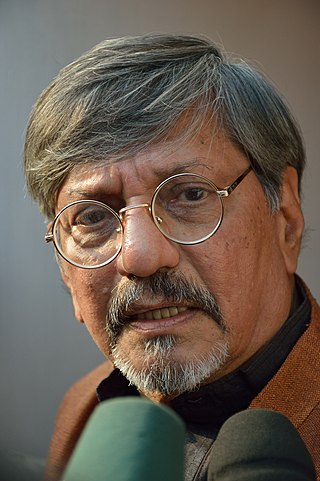
Amol Palekar is an Indian actor, director and producer of Hindi and Marathi cinema.
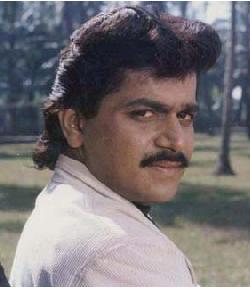
Laxmikant Berde was an Indian Marathi language film actor who appeared in Marathi and Hindi movies. Known for his highly energetic slapstick performances, Berde started his career as an employee in the production company Mumbai Marathi Sahitya Sangh and then played supporting roles in a few Marathi stage plays. In 1983–84, he first became famous with the Marathi play Tur Tur.
Tapori can refer to:
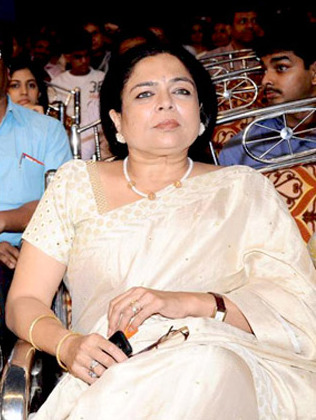
Reema Lagoo was an Indian theatre and screen actress known for her work in Hindi and Marathi cinema. She began her acting career in the Marathi theatre, after which she became a household name for playing motherly roles in the 1990s and early 2000s. She became a household name after her roles in the 90s classic TV sitcoms Shriman Shrimati and as Devaki Verma starring opposite Supriya Pilgaonkar in Tu Tu Main Main.
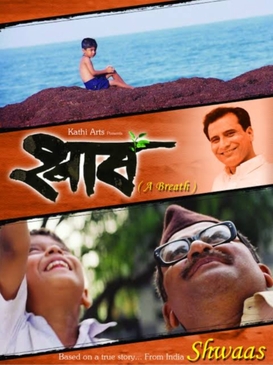
Shwaas is a Marathi film, released in 2004. It was India's official entry to the 2004 Oscars and was ranked 6th in the Academy Award for Best Foreign Language Film category. Its storyline is based on a real-life incident in Pune. With a low-budget of the Indian rupee of 65 lakhs (6 million), Shwaas won the National Award for best film in 2004, nearly 50 years since a Marathi film last earned this title. Directed by debutant Sandeep Sawant, it was shot in 33 days at Sindhudurg, Konkan, Pune and at KEM Hospital in Pune. Shwaas was acknowledged as a "significant turn for Marathi cinema" which had been going through a low patch. After its success, it was released in Hindi, Bengali and Tamil languages.

Nagma Arvind Morarji is an Indian politician and former actress. She was a popular lead actress in the 1990s. She made her cinematic debut in the film Baaghi opposite Salman Khan in 1990. It was Hindi cinema's seventh highest-grossing film of the year. She is known for her roles in films like Gharana Mogudu (1992), King Uncle (1993), Suhaag (1994), Kadhalan (1994), Baashha (1995) and Lal Baadshah (1999). She began her acting career in Bollywood. Nagma has acted in a broad range of films in India's languages predominantly in Telugu, Hindi, Tamil and Bhojpuri films and has also additionally appeared in several other regional language films such as Malayalam, Kannada, Bengali, Punjabi Marathi.
Shemaroo Entertainment Ltd. is an Indian content creator, aggregator and distributor, specifically in the media and entertainment industry. It was founded by Buddhichand Maroo in 1962 as a book-circulating library under the name Shemaroo. It set up India's first video rental business in 1979. The company went national after it began content distribution in 1987, became aggregators and bought rights to movies for home video.

Marathi cinema, also known as Marathi Chithrapat, is the segment of Indian cinema, dedicated to the production of motion pictures in the Marathi Language widely spoken in the state of Maharashtra. It is based in Mumbai. It is the oldest film industry of India and one of the leader in Filmmaking in India's film industry. The first Marathi talkie film was Ayodhyecha Raja, released in 1932, just one year after Alam Ara the first Hindi talkie, before releasing the Aayodhyecha Raja, all the Marathi films until then were Silent films with Intertitles.

Sai Paranjpye is an Indian movie director and screenwriter. She is the director of the award-winning movies Sparsh, Katha, Chasme Buddoor and Disha. She has written and directed many Marathi plays such as Jaswandi, Sakkhe Shejari, and Albel.
Parsi theatre is a generic term for an influential theatre tradition, staged by Parsis, and theatre companies largely-owned by the Parsi business community, which flourished between 1850 and 1930s. Plays were primarily in the Hindustani language, as well as Gujarati to an extent. After its beginning in Bombay, it soon developed into various travelling theatre companies, which toured across India, especially north and western India, popularizing proscenium-style theatre in regional languages.

Modern Standard Hindi is mutually intelligible with Urdu, the national and official language of Pakistan. Both are standard registers of the Hindustani language. As a result of linguistic and cultural similarities, Hindi has had notable influences in Pakistan and is taught as an academic subject in some institutions; before the partition of colonial India, Hindi was taught at major universities in the provinces that came to form Pakistan. While Hindi and Urdu both have a predominantly Indic (Indo-Aryan) base, Hindi uses more Sanskrit words in its educated vocabulary while Urdu incorporates more Arabic, Persian, and a few Turkic words for the same. Most poetry, ghazals, qawalis & lyrics use many Urdu words.
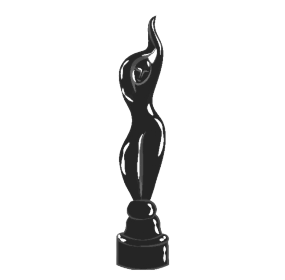
The Filmfare Marathi Awards are presented annually to both artistic and technical excellence of professionals in the Marathi film industry of India. The ceremony had been sponsored by various private organisations in the past as well as in present provisions. During several years in 1990s, a live ceremony was broadcast to television audiences but was later discontinued due to unknown reasons. In 1963 the awards were extended to Marathi, Tamil, Telugu and Bengali languages. The presentation of the awards has been inconsistent throughout its inception. Presently, a recorded and edited version of the awards ceremony is televised.
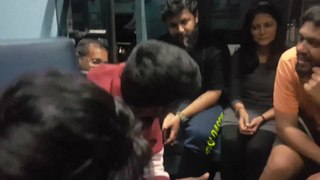
Gully rap is an emerging genre of hip-hop music that originated from Mumbai. It has since spread across India. Inspired by American rappers like Tupac, The Notorious B.I.G. and Nas the music discusses the street life in distinct Hindu-Urdu rhythm and cadence. Gully means "narrow lane" in Hindi. DIVINE and Naezy are artists that are considered at the forefront of the genre. It stands in contrast to mainstream desi rap or Bollywood which focus on more superficial aspects of life. By contrast, gully rap has a socio-political emphasis.
References
- 1 2 Mazumdar, R. 2007. Bombay Cinema: An Archive of the City. Minneapolis: University of Minnesota Press
- ↑ Jeffrey, Craig (14 July 2010). "Timepass: Youth, class, and time among unemployed young men in India". American Ethnologist. 37 (3): 466. doi:10.1111/j.1548-1425.2010.01266.x.
- ↑ Tapori Children's Network - ATD Fourth World